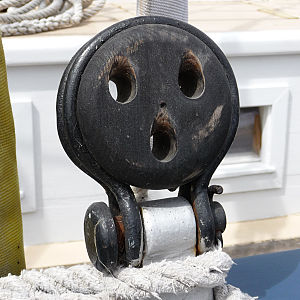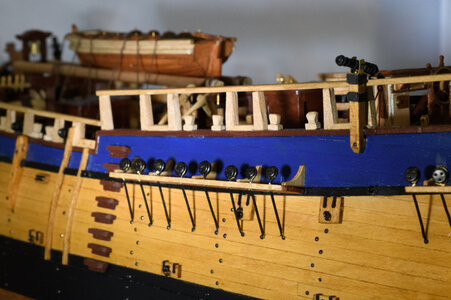Hello, Kramer. I have not found evidence, nor references in my collection of books, that deadeyes (in form of shave-less blocks) were painted of any kind. Historically, deadeyes are made from Lignum vitae wood. It is hard, durable, and is also the densest wood traded. It will not float and will easily sink in water. On the Janka scale of hardness, which measures the hardness of woods, lignum vitae ranks highest in the trade woods. Due to the density of the wood, belaying pins, and deadlines on sailing ships were made from lignum vitae. Such an example of deadeyes found aboard the USS
Constitution.
I think the dark color mostly comes from the combination of sea and climate, due to constant exposure to the sun with splashed water in a rough sea. In the picture below, you can see light colored wood (specifically in the eyes, where tear exists). They might be once tarred as protection to avoid ovedring when expose to the sun.
View attachment 325837
A deadeye is an item used in the standing and running rigging of traditional sailing ships. It is a smallish round thick wooden (usually lignum vitae) disc with one or more holes through it, perpendicular to the plane of the disc. Single and triple-hole deadeyes are most commonly seen. The three-holed blocks were called deadeyes because the position of the three holes resemble the eye and nose sockets of a sheep's skull. Single deadeyes (or bull's eyes) are used to guide and control a line and, particularly in older vessels, to change its direction. More modern systems would use a block for this purpose but in traditional rigs with many lines to deal with, designed when blocks were relatively expensive to make, a deadeye provided an acceptable compromise. When blocks came into common use for adjusting running rigging, deadeyes continued to be used for tensioning standing rigging. Triple deadeyes are used in pairs; a line called a lanyard is run back and forth between them, through the holes, so that they function again much as a block and tackle would. This provides a mechanical advantage, pulling harder on whatever the deadeyes are attached to. Pairs of deadeyes are placed in the shrouds (the lines that hold up the mast), where they are used to create greater tension in the shrouds. To set up the lanyards used with dead-eyes, a suitable grease such as tallow is first applied to the holes. After reeving the lanyard through the deadeyes, the end is hooked to a handy purchase in the rig above, such as the throat halyard. By hauling on the halyard the lanyard in the deadeyes is drawn up taut. A small wooden wedge is knocked into the last hole, to prevent the lanyard sliding back, and the end is unhooked from the purchase and made up on the shroud above the upper deadeye. The wedge can then be removed ready for the next shroud. As an alternative the tackle on the lanyard can be made fast to the shroud well above the upper deadeye so that it compresses the deadeyes. The last part of the lanyard can then be seized to an adjacent part between the deadeyes. When this is finished the tackle is cast off and the lanyard made off.









